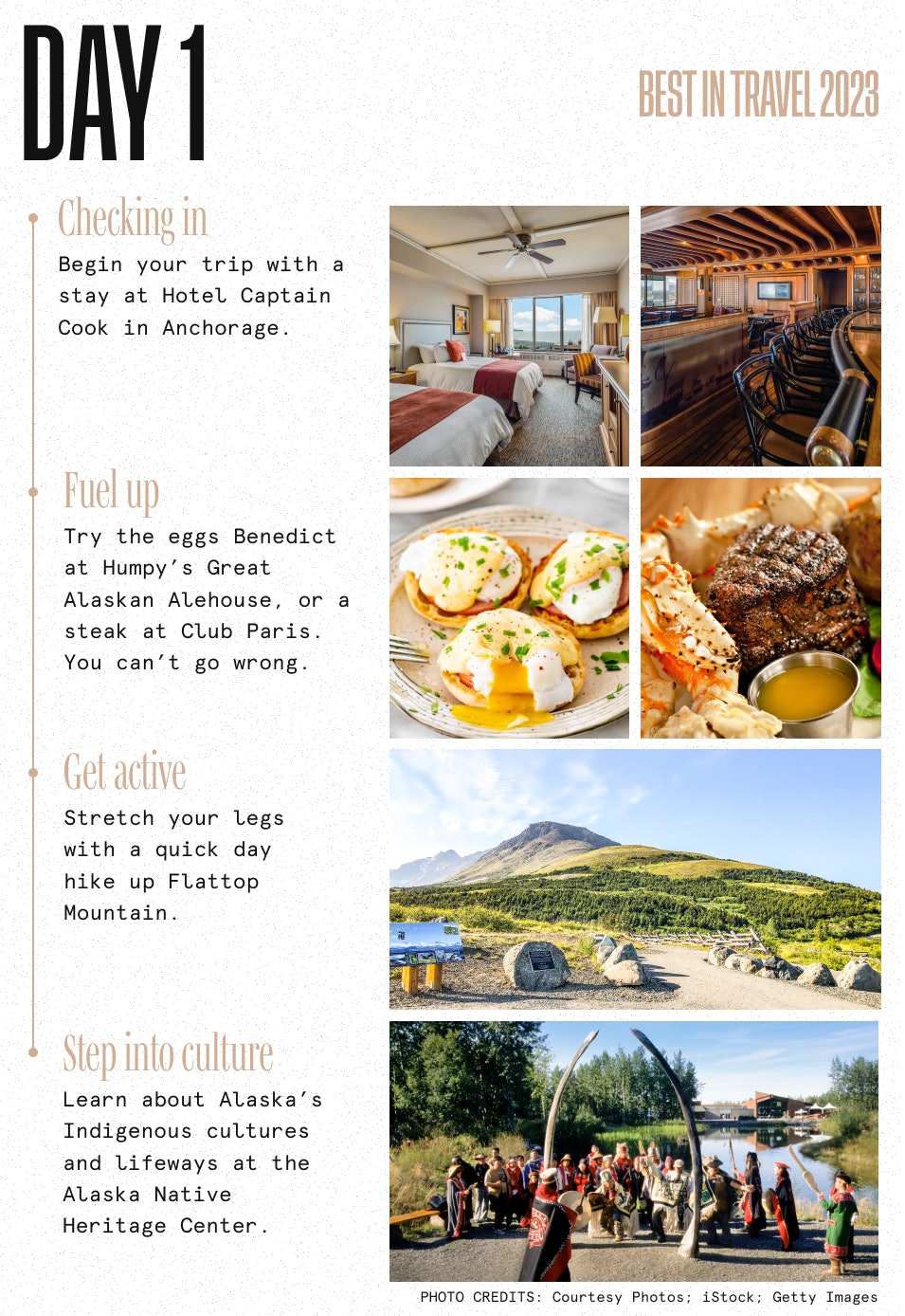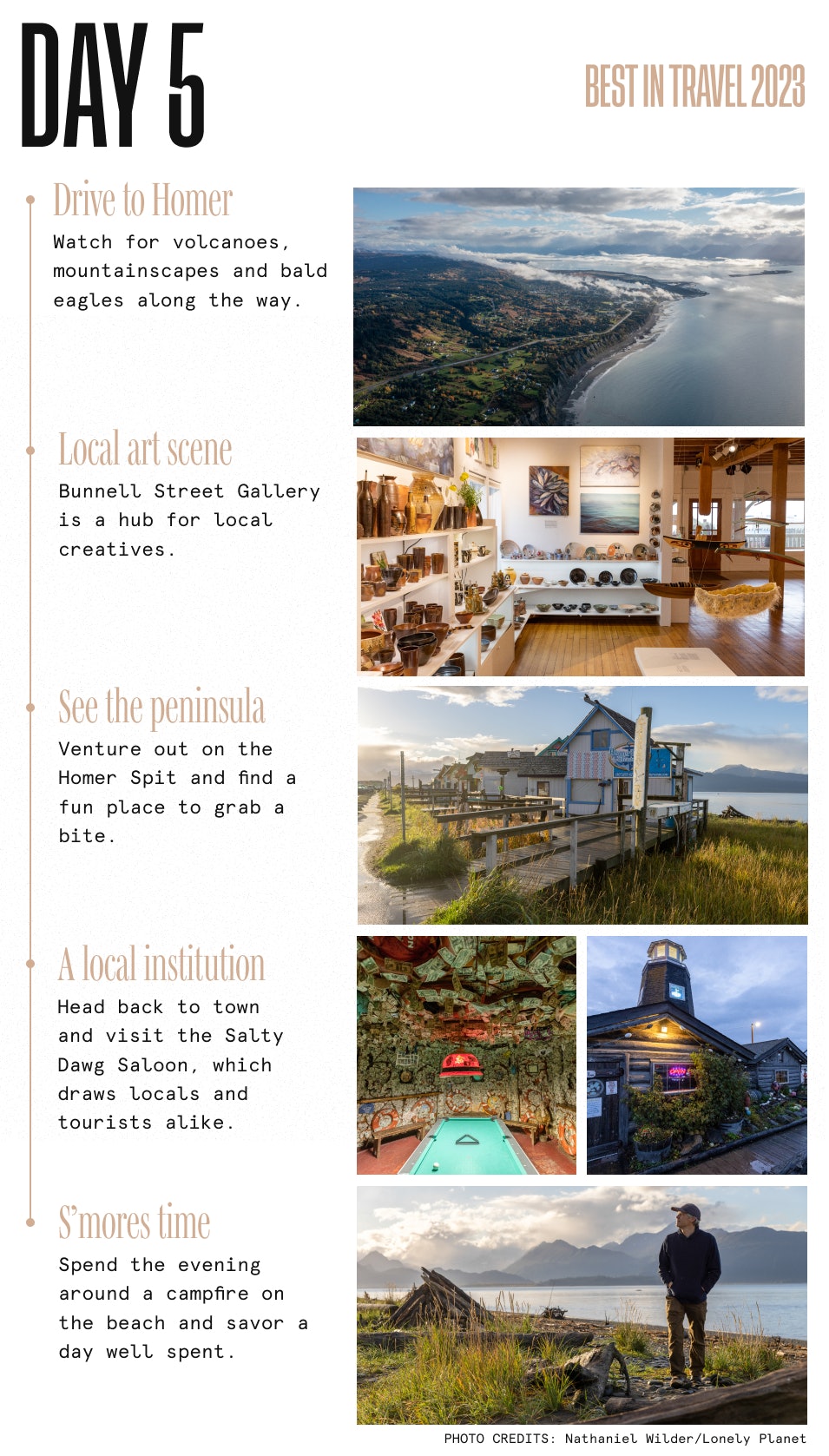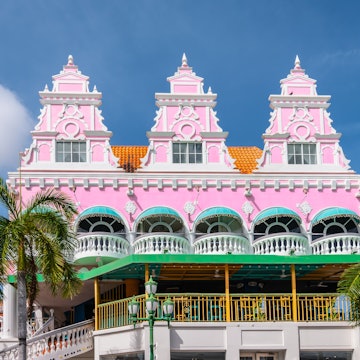

Watch of wildlife among the cliffs of Kenai Fjords National Park © Nathaniel Wilder/Lonely Planet
Along with its spectacular wildlife, gorgeous fjords and glaciers, Alaska is also a great place to learn about Native Alaskan culture and is an example of Indigenous groups managing authentic tourism experiences that also embrace sustainability.
Alaska Native Richard Perry maps out an eight-day road trip that will help you see the vastness of Alaska while connecting with its wilderness and people.

I am Yup’ik and Gwich’in Athabascan (commonly called Alaska Native). An artist, writer and regularly published journalist, I have lived in Anchorage, Alaska for over 18 years, having moved here in 2004 to care for my family. During my time in Alaska, I have found far more than I ever expected, learning about my Alaska Native family and cultures through my work with Alaska Native communities. Essentially, I reclaimed a greater sense of my identity. As you follow this itinerary, I hope you enjoy a new perspective on the mountaintops, glaciers, wildlife and genuine vastness here.

Why you should get to Alaska this year
From the near-mystical experience of the Northern Lights to incredible glaciers, wilderness and wildlife, mountains and valleys, you will discover that Alaska is a distinct, vast and beautiful place. The largest of the USA’s 50 states, Alaska has five different climate regions; often, distances between destinations are discussed in hours rather than miles. Traveling in Alaska is challenging compared to other states, with more than 80 percent of rural communities off the road system and only accessible by small aircraft or bush planes.
Successful in business and vital to the Alaskan economy, the Indigenous population is as diverse and unique as the state. Alaska Native people comprise some 23 languages with six distinctive groups: the Iñupiaq, Yup’ik, Aleut (or Unangan), Eyak, Tlingit, Haida, Tsimshian and Athabascan cultures.

Explore – and stock up in – Anchorage
Upon arrival in the Last Frontier, check in to Anchorage’s luxurious Hotel Captain Cook. (Keep in mind that elsewhere in Alaska, “luxury” usually means proximity to nature rather than five-star amenities.) If you’ve arrived hungry, head to downtown Anchorage and to one of my favorite spots: Humpy’s, where the prices are relatively moderate and the eggs Benedict with salmon crumbles and fresh halibut are delicious. Note that the dress code most everywhere in Alaska is weather-dependent, with Carhartt wear always appropriate. I’ve never eaten anywhere with a dress jacket requirement or similar (though carrying a light winter coat is always a good idea).
Another great place to eat for lunch or dinner is Club Paris, a steakhouse that’s been around since the 1950s. The fried Alaskan halibut fingers make for a delicious appetizer, while you can’t go wrong with any cut on the menu (though, as the menu warns, the house cannot guarantee the quality and tenderness of steaks ordered well done).
If you start your day early, consider a mini outdoor adventure – perhaps a quick day hike up Flattop Mountain, generally considered the most climbed mountain in Alaska. While the trail to the summit is challenging, several loop trails below are perfect for beginners or those with physical limitations. In fact, many sightseeing tours stop here for views of the city and mountains.
Next, visit the Alaska Native Heritage Center, where you can learn about Alaska Native cultures and lifeways through programs led by Alaska Native people, often youth. An Indigenous guide can lead you through Impressive life-size village sites, while a permanent collection includes regalia and other exciting artifacts.
We’ll be on the road this week, so there are a few things you should do today to get ready. First, since there are several long stretches of road with no gas stations, make it a habit to fill up your tank whenever you can. You might stock up on bear spray, a smart idea for any hiking trail, or whenever you’re outside of a vehicle or a building.
Since several areas in your travels will have no cell service at all, we suggest printing out maps and directions rather than relying on GPS. You can also ask directions from a local. That could be fun.
Stock up on beverages and snacks in Anchorage – which will have higher prices than you’re used to in the Lower 48. Another smart buy: inexpensive blankets, which are bulky to pack for plane travel but quite useful on a windy beach or lookout spot. With the weather always changing, dress in layers to adjust to the temperature differences and varied activities throughout each day.

On to Girdwood
It’s time to take to the Seward Highway, one of the most beautiful routes in Alaska, for the 45-minute drive to Girdwood. The road meanders along the shoreline of Turnagain Arm (a waterway into the Gulf of Alaska), with the 3000ft (915m) peaks of Chugach State Park rising on your left. Dall sheep precariously roam the steep ledges, and you may even catch sight of a bear.
When you get to Girdwood, check into Alyeska Resort (from $300 per night), a resort set in a valley surrounded by mountain peaks, glaciers and wilderness.
Since I bet you like novel experiences as much as I do, check out gold panning at the Crow Creek Mine. Surrounded by historic buildings, rustic mining equipment and superb mountain views, you can pan in the creek area for gold. Whatever you find, you get to keep.
Trails near Girdwood offer moderate to challenging hikes – though the Winner Creek trail is on the easier side. Along its mile-and-a-half length, you’ll cross bridges over rushing rivers, before a moderate climb to the top of the gorge, which has impressive views of the upper valley. If you’re not up for this effort, hop on the Alyeska Resort Aerial Tram ($35) and enjoy the mountain views as you quickly ascend.
Aleyska’s Double Musky Inn restaurant (no reservations; expect a wait on weekends) serves up – surprisingly – delicious New Orleans–inspired fare. The feel is “Cajun in a log cabin,” with a rustic dining room bursting with beads, mirrors and other Mardi Gras paraphernalia. Entrees range from French pepper steak to a prime filet with béarnaise sauce. Save room for dessert: the Musky pie is a rich, creamy chocolate treat made with a pecan-and-cracker crust.

Cross Moose Pass en route to Seward
Today, we’re driving along the rest of the Turnagain Arm to Seward, via Moose Pass. The 90-mile (145km) drive meanders along the shoreline before entering a mountain valley. The road is well traveled by sleeping vans, trucks with boats in tow and campers; you’ll need patience if you hope to pass. Frequent viewing spots offer the chance for breaks; if you’re lucky, you might spot beluga whales or impressive bore tides.
You’ll also spot curious sights with historical resonance, many from a catastrophic 1964 earthquake that lowered the ground of the surrounding area by as much as 10ft (3m). Keep an eye out for an abandoned gray horse stable and cabin that appears to be sinking into the wetlands. The “ghost forest,” with bare trees killed by the saltwater flooding following the quake, is a melancholy reminder of the catastrophe.
If you wander from your car, take great care – and be sure to make noise so as to not surprise the bears. Also keep in mind that moose do not like dogs, so keep your pets on a leash at all times.
Once you reach Seward, stay at the Kodiak Cabin for two nights (from $170 per night). From there, I suggest heading out to the Alaska Sealife Center ($30), which combines a public aquarium (all animals native to Alaska) with work in marine research, education and wildlife response. Kids (and kids at heart) will love the touch pool, where you can get hands-on with sea cucumbers, anemones, starfish and other small sea creatures.

Admire astonishing glaciers and fjords
Seward has a dining scene centered around local seafood. Take a walk around town after your road trip, strolling by the docks and stopping for a bite at Highliner Restaurant or Gold Rush Bistro.
The highlight of today is a four-hour cruise to the Kenai Fjords and Resurrection Bay ($115). Departing from Seward harbor, you’ll travel a 55-mile route along the scenic coastline, with incredible views of rugged cliffs with seabird rookeries, patches of rocky beaches where sea lion colonies rest and magnificent Bear Glacier. From the deck, keep an eye out for passing whales, Dall sheep, porpoises, sea otters, mountain goats and eagles. Spotting a pod of orcas breaching is one of those lifelong memorable moments. (Keep in mind that rough waters can induce seasickness in many. I recommend taking candied ginger, herbal tea, peppermint candies or over-the-counter anti-nausea pills with you just in case.)
Exit Glacier is accessible by road – and explorable by foot. If you’re up for a hike, you can take to the trails and walk very close to an active glacier, or take a ranger-led walk to see the ice up close. As an alternative (and if you still have time and energy!), check out Lowell Point recreation site and coastal beach walk, an excellent spot for spotting marine mammals and birds. Take a flashlight if you plan to explore the abandoned Fort McGilvray site, as it can get dark quickly.

World-class seafood and campfires in Homer
Our next leg takes us on the three-and-a-half-hour drive from Seward to Homer. Along the way, watch for volcanoes, mountainscapes and bald eagles that frequent this part of the Kenai Peninsula.
Occupying a building dating to 1937, Old Town Bed & Breakfast is Homer’s most charming accommodation. (Since there are only three rooms, reserving ahead is essential.) On the ground floor is Bunnell Street Gallery, a center with space for art exhibitions, performances and educational programming – and a hub for local creative types. Next, hit the Homer Spit, a small peninsula with rocky beaches and some sandy areas, plus numerous bars and restaurants. If you’d like to go farther afield, you can arrange a halibut-fishing excursion, bear-watching tour or (for a splurge) a helicopter flight above the stunning scenery.
Homer restaurants serve some of the freshest seafood I’ve ever had – visit Captain Pattie’s, a casual fish joint on the Spit, to taste for yourself. Salty Daw Saloon, in a building dating from 1897, is a well-worn Homer institution for tourists and locals alike. (Note that if you’re tall, you may need to duck into the bar.) If you like beer, you should taste what’s newly on tap at Homer Brewing Company.
Note that Homer can be thronged with visitors in the warmer months; set out in the morning to enjoy a bit less bustle. My partner and I enjoyed simply hanging out, building a fire on the beach and cooking some brats and s’mores over the flames (enjoying a few beverages, too). Since the sun shines long up here in the summer, you may find yourself staying out later than you thought. When you return to the B&B, you’ll be tired and smell of the campfire – the sign of a day very well spent.

Home in on more in Homer
Take your time waking up, then have a leisurely breakfast at Two Sisters Bakery. If you want to stay put, wander back out along the Spit and mingle with local musicians and visitors from all over the world. (You can also simply people-watch.)
Even if you’re not a seasoned fishing person (and I’m not one), there is a perfect spot to give it a go: the Nick Dudiak Fishing Lagoon (better known as simply the Fishing Hole) on the Spit. After you’ve secured a fishing license and the right gear, try your hand at casting for silver (coho) and king (Chinook) salmon from a stocked lagoon.

Fish for salmon, while avoiding bears
It’s on to Kenai as we begin the loop back toward Anchorage. If the weather’s clear on the 90-minute drive, keep an eye out for monumental, majestic Denali, over 150 miles away; local Alaskans often check to see if “the mountain is out.” (Its apt name means “the Great One” in Koyukon Athabascan.) Take a room at Kenai Princess Wilderness Lodge, which offers lovely amenities and great views.
As you pass the Kenai and Russian Rivers, the roads narrow, with mountain cliffs on one side and otherworldly, bright-turquoise water on the other. Finely ground sediment from glacier runoff absorbs and disperses sunlight, giving the water this vivid, almost magical appearance. In the summer, the Russian River teems with thousands of sockeye salmon – as well as fishermen attracted by them.
They’re not the only ones: if the bears are awake, you’ll have a good chance of spotting a few around 200 yards further downstream, as they seek out salmon for themselves. It was along the Russian River that I had my first encounter with a brown bear in the wild: I was walking along its lower banks when I heard a distinctive low grunt. I stopped in my tracks and walked backward (never turn your back or run from a brown bear!), slowly returning to the path.
Once I made it back to my fishing companion, a young brown bear came to the top of the hill where I had been only moments ago, then moved quickly to the bank at the very moment a fellow angler pulled in his catch. The bear grabbed the salmon from the fishing line then retreated over the hill. The people fishing nearby yelled and hollered…to no avail!
The hiking in this area is exceptional (the Russian Lakes trail is a great choice for hikers of all fitness levels). Just remember to not go solo, make plenty of noise as you move forward on the paths and never set out without bear spray. Avoid carrying food and using any fruit-scented personal-care products.

Take a few detours on the way back to Anchorage
Our last leg (three to five hours) takes us back to Anchorage. Perhaps you want to drive straight through and reflect on all you’ve already seen. But if you want to cram in even more, turn off for a detour to Hope, a small community founded in 1889 as a gold-rush town. On the drive in, alongside Resurrection Creek, look up to see groups (or, more poetically, “soars”) of eagles flying, sometimes only a few feet overhead. Not until you get so close will you grasp the immensity of their wingspans.
Near the Portage exit, the Alaska Wildlife Conservation Center ($19) helps preserve Alaska’s wildlife through conservation, education and research; many species of Alaskan wildlife are cared for here. If you’re fortunate, you might find yourself three steps away from the animals – which include grizzly bears. (Don’t worry: there are safety fences.) On one visit, I arrived as the handlers were feeding the bears small fish. I was close enough to smell and hear one breathe, and watched as a huge adult male used his claws like a delicate fork, tearing the flesh of the small fish as skillfully as any chef before gently bringing the meat to his mouth. You might also spot eagles and moose, and watch salmon jump.
Depending on time, you can also visit Portage Glacier, one of Alaska’s more accessible glaciers and a great spot for exploring and hiking. Or just relaxing: I am always content to sit by the small, glacier-fed lake and watch the light-blue glacier ice float by. (Note that with the wind here, you’ll need those blankets.)
As you approach the city, get one more dose of nature at Potter Marsh bird sanctuary, a protected area with a boardwalk from which you can spot Canada geese, northern pintails, canvasback ducks, red-necked phalaropes, red-necked grebes and the occasional bald eagle. An inspiring place indeed to end an unforgettable journey.
















